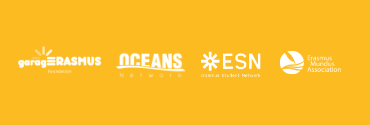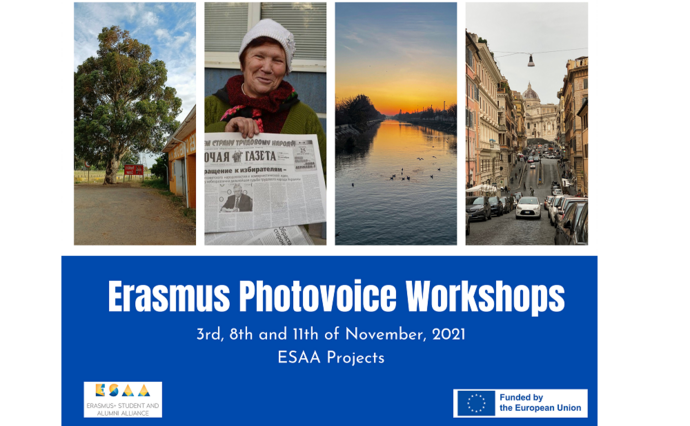News
The Erasmus Photovoice Workshops took place successfully in November 2021
On the 3rd, 8th and 11th of November 2021, the inaugural Erasmus Photovoice Workshops were hosted with the theme of acculturation of Erasmus and non Erasmus students during the Covid-19 pandemic. The aim of these workshops was to create an engaging interactive platform where participants shared their images and interpreted their images through the lens of Photovoice and photography during the Covid-19 pandemic.
The Erasmus Photovoice Workshops covered everything from basic concepts of photography, to learning how to tell a story through a photo. It also documented the social realities of students and the cultural significance of photos. As commented on below by our resident Photography expert:
“Maybe we can interpret an image through our cultures and the things that surround us. That is why my lecture on photos might not be specific to South Africa only, as each culture has its own visual culture but there are still things that are shared in common. That is super interesting. (Patricia, Spain, Photography expert)”
What exactly is Photovoice?
It is a methodology created by Wang and Burriss (1993) where participants use the lens of images accompanied by interpretive narratives to document their social realities (Swarts et al., 2021). It promotes critical analysis and empower individuals through knowledge construction and fostering change. In this instance the sample group was a combination of both Erasmus and non Erasmus students.
Research Participants
Twenty five participants had applied to be part of the project. These participants came from 3 different continents (Africa, Europe and Asia). We received applications from diverse nationalities including: Spain, Belgium, Kyrgyzstan, Italy, India, Tunisia, Greece, Croatia, Georgia, China, Romania, Poland and South Africa. The Erasmus Photovoice workshops comprised both Erasmus students and non Erasmus participants particularly from Georgia, India and South Africa. This was done to promote and foster the Erasmus programme to students who have not participated in an Erasmus exchange yet.Of the non-Erasmus students many had been enrolled in higher education institutions such as Universit of Western Cape, South Africa.
About the Photography Workshops
The workshops were facilitated by Photography expert Patricia Serra Clavel, from Valencia Spain, who holds a high level technique degree in artistic photography at the school of design EASD, Valencia. She gave our participants valuable feedback during the three masterclasses, incorporating both technical and conceptual properties into the workshops. Technical concepts such as how to take advantage of the tools in your camera and phone, properties of light (amount, quality and direction) frame and composition were discussed. Conceptual properties such as vanishing points, rule of thirds, rule of diagonals, shapes and symmetry were also covered. Participants were taught the importance of how to value a photo and different ways to appreciate a photo such as through its photographic, sociological, symbolic, aesthetic and emotional value. The photovoice component and focus group interviews were facilitated by Tarynne Swarts who holds a Masters Degree in Education from Kuleuven, Belgium and is a current PhD student on international student mobility at Wits.
The Erasmus Photovoice Workshops covered everything from basic concepts of photography, to learning how to tell a story through a photo. It also documented the social realities of students and the cultural significance of photos. As commented on below by our resident Photography expert:
“Maybe we can interpret an image through our cultures and the things that surround us. That is why my lecture on photos might not be specific to South Africa only, as each culture has its own visual culture but there are still things that are shared in common. That is super interesting. (Patricia, Spain, Photography expert)”
Themes:
Five main themes were extracted from the photovoice narratives. 1. Man versus nature; 2. Adaptation during Covid-19 times; 3. non-citizenship; 4. Using photography; 5. Cultural awareness:
1. Man versus Nature
Man versus nature was a theme that was thought provoking. Many of the participants had commented on the refuge they found in nature and the restoration to the planet. With the current climate crisis and global warming the pandemic gave much needed restoration and relief to the Earth and many captured these moments. Some had mentioned how flocks of animals returned to rivers due to the absence of man and pollution which is echoed below by Romanian participant Ana below who did her Erasmus in Germany.
“I woke up early in the morning to take this photo. I didn't have a big plan when taking this photo only to show the sunrise. As I reflect on this photo I think I took the perfect shot of covid times. As there are no people but nature is still there, the birds are there and that the sun always rose irrespective of the pandemic (Ana, Romania/Erasmus Germany)”
Tidimalo, non Erasmus from South Africa reflected the socio-economic challenges that the pandemic brought on with the closure of shops and places of meaning no longer having the same meaning but despite those challenges, there was always something bigger in nature as reflected by his interpretation below:
“With this photo, I wanted to express the boredom I experienced during Covid-19 times. So for the photovoice task I went to a place that used to be very lively and now it is empty and dead. A place that had so much significance to me before Covid because of the people and liveliness now no longer had the same meaning. At the same time I wanted to show that even when a place seems dead there is always something bigger, and as you can see there is this big tree and the moving clouds that signify something bigger. (Tidimalo, South Africa, non-Erasmus)”
2. Adaptation during Covid times
Adaptation during the Covid pandemic was an important theme as the world was uprooted and students had to adapt quite quickly to the new changes as expressed below by Francesca:
“I learnt to find the balance from the inner and outside parts of the world because there were only me of course in that period. Usually I give the fault of my problems or to the context I am living in but in that situation I had to find the balance by only searching from within myself. And actually only now succeed in it. The challenge was to be fast because I need to adapt again to the new routine. For example with the university it was hard in the beginning as it was quick to go online, and I had to learn very fast and not lose precious time in adapting or you will be left behind. (Francesca, Italy, Erasmus Germany).”
Some participants mentioned the difficulties in interacting and making friends with the host nation as the pandemic made it more complex to connect with people as quote by Aizada below:
“The pandemic made it a lot harder to interact with people but other than that I found that Italian or southern European people are more open to connections and to making friends. (Aizada, Kyrgyzstan, Erasmus, Italy)”
3. No citizenship
Many of the participants questioned the idea of lack of access, immigration and non-citizenship. Spanish participant below commented on his appreciation towards his European passport as many people do not have the same privileges as seen below:
“Making an Erasmus made me immensely grateful for so many things, especially for the passport I carry. It remind3ed me not to take it for granted since so many people don’t have access to the same privileges as European people. (Angel, Spain/ Erasmus in Ukraine)”
4. Using Photography as a tool
The concept of Photovoice was new to many participants and they fully embraced this new idea of visually representing a story through the lens of photography as discussed below by South African:
“I use photography to display certain images of poverty and with the projects we did I just found that visual representation just evoked a different type of emotion in terms of research. We become so used to reading about someone then we use photography and you can see it in front of you and I decided to do that work and focus solely on photography in terms of portraying a message or an historical message. (Nishaat, South Africa, non-Erasmus)”
5. Cultural awareness
The theme of intercultural and cultural awareness was also very predominant. The hidden elements of cultural learning that one can only experience when in a different culture was discussed by Indian participant, Saya below:
“I ponder that Cultural awareness is not just about learning facts and do’s and don’ts about different cultures, but also about the unseen elements of culture such as values and beliefs, that are usually hardest for people to recognize, understand and deal with. (Saya, India-non-Erasmus)”
Conclusion
The Erasmus photovoice workshops gave us great insight into the opportunities and challenges Erasmus and non Erasmus students experienced during the Covid-19 pandemic. Some insightful themes were extracted from the narratives. These themes make us question important themes such as climate change, immigration and general challenges of stereotypes still experienced in the world. Erasmus programs offer the opportunities to broaden your worldview and find solutions to these problems and by using the lens of the camera enables us to see first hand the challenges experienced. The participants were very engaging and grateful to be part of this project and we would like to end off with the following message of thanks from one of our Participants, Hlanganani who did his Erasmus abroad in Germany.
“Thank you for this opportunity. I really do appreciate it. I have never done a photography course or workshop ever and it is the first time ever I am a part of this. It is something I am really happy to be part of and something I am passionate about and to see everyone’s point of view, is eye opening. (Hlanganani, South Africa Erasmus Germany)”
Text by Tarynne Swarts
23.12.2021


